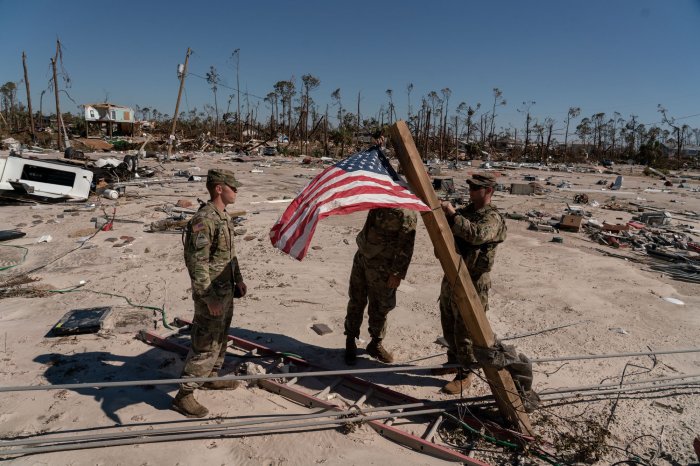<< Show Caption >>
Oct. 12 (UPI) -- The death toll from Hurricane Michael rose to 13 Friday as emergency officials said a "tremendous number of people" were unaccounted for in Florida's Panhandle.
Though the post-tropical cyclone moved into the Atlantic Ocean, its outer bands dumped rain and produced damaging winds in North Carolina on Friday. Michael made landfall near Mexico Beach, Fla., Wednesday with 155 mph winds -- just below Category 5 strength -- and peeled off roofs, flooded streets and uprooted trees.
The storm killed at least 13 people, mostly from trees falling onto houses.
Among the dead are seven from Virginia, four in Florida and an 11-year-old girl in Georgia, officials said.
But that number could inch up as emergency crews work to sort through the wreckage and assess who might be missing.
"A tremendous number of people" are "unaccounted for" in Mexico Beach, Mark Bowen, chief of emergency services in Bay County, told Good Morning America.
"Fire stations were destroyed, police stations were destroyed," Bowen said. "Public safety agencies are only taking highest priority calls right now ... heart attacks, you know, major trauma. ... An enormous amount of 911 calls are going unresponded to because we've got this priority to search and rescue. So it's a terrible thing," he added.
The American Red Cross had 500 disaster relief workers providing food, water and shelter to victims of the storm. The Coast Guard rescued more than 60 people and assisted another 300 as of Friday.
Charles Alexander, director of contingency operations for the U.S. Army Corps of Engineers, said there is no significant damage to dams or levees.
U.S. Health Secretary Alex Azar declared a public health emergency in Florida, offering flexibility to patients on Medicaid and Medicare. HHS offered assistance to patients who rely on ventilators, dialysis and other medical equipment that needs electricity. The federal agency will also provide hundreds of medical professionals to the area.
Storm surges were the greatest threat for coastal areas, with the largest recorded at 14 feet.
The largest blackouts were in Virginia, where officials said more than 450,000 customers were without power. That figure is 403,000 in North Carolina, 278,000 in Florida and 145,000 in Georgia.
Two hospitals in Panama City, Fla., where Michael arrived Wednesday, were evacuated due to damage. The Bay Medical Center Sacred Heart moved 200 patients, including 39 critically ill.
Some Floridians returned to their homes to assess damage late Thursday. Deidre Hawthorne's family stayed in a shelter during the storm and returned to find their home still standing -- but with fallen trees blocking the front door.
Walls and windows were sucked out of a Holiday Inn in Panama City, where many evacuees were sheltered. Shards of glass and pieces of clothing could be seen throughout the hotel. Cellular service is limited and there's no Internet access at all, officials said.
President Donald Trump on Thursday approved disaster declarations for four Florida counties, clearing the way for federal aid to the hardest hit areas. That includes grants for temporary housing and home repairs, low-cost loans for uninsured property losses and other programs to help with recovery.
Federal Emergency Management Agency director Brock Long said Thursday that Mexico Beach, Fla., took the brunt of the storm and is "ground zero."
"Anytime you have a significant storm surge event, roadways and bridges are greatly impacted and you have to survey those before you move power crews in," he said.















